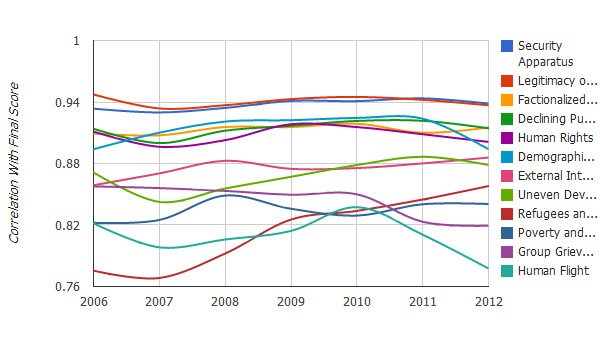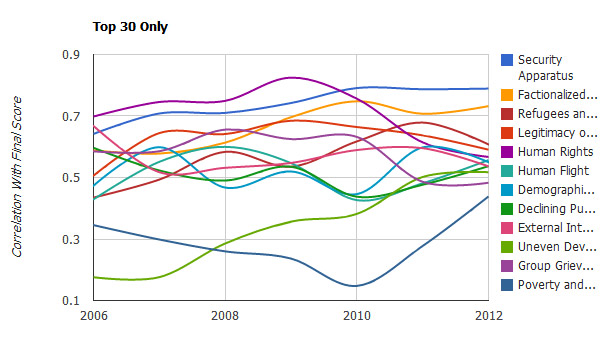-
What Are the Most Important Factors in the Failed States Index?
Last week, the Fund for Peace issued its eighth annual Failed States Index (FSI). The index gives 177 countries a score between 1.0 and 10.0 for 12 indicators, ranging from the legitimacy of the state and the security apparatus to demographic pressure and uneven development (high being bad, low being good – see full descriptions of the indicators here). But which of these indicators has the biggest impact? We did a quick analysis of the Failed States Indexes published from 2006 to 2012 to show which of the indicators correlate most with a high score. (We skipped 2005 since the roster of analyzed countries was significantly smaller.)
As might be expected considering how many variables the Fund for Peace’s analysts have to aggregate, the methodology of the index is not without controversy. But it is also used as a tool for many, and the term itself – “failed state” – has become ubiquitous.
Much of the analysis surrounding the index focuses on the paths different states have taken since the first index in 2005. Somalia, for example, has been rated “number one” for the past five years, and Libya dropped 61 spots in the past year.
By calculating how closely a given variable correlates to a country’s total score, it’s possible to track how closely each indicator is associated with state failure, as measured by the Fund for Peace (the closer the calculated correlation is to one, the more closely associated the variable is with a high score).
Some of the indicators appear to be related. For instance, mounting demographic pressures, the progressive deterioration of public services, and the violation of human rights and rule of law follow a similar curve. Intuitively, this makes sense; states facing demographic pressure like a rapidly growing population may find it more difficult to provide public goods for a larger number of citizens. Basic services like health care can be overwhelmed by the amount of people needing treatment.
However, correlation does not necessarily mean causation. Indeed, some of these variables could be the result of state weakness, not the cause.
“Some variables are leading indicators and some are lagging,” said Nate Haken of the Fund for Peace in an email. “But for the sake of the FSI we measure the symptoms of state weakness, and make the assumption that the pathology of state failure looks roughly the same everywhere.”
Examining the Top 30
The circumstances for countries on high alert – the top 30 on the index every year – look quite different. While the cluster of variables is much tighter, correlation is much lower. Mounting demographic pressures was one of the leading variables for all states surveyed, for example, with a coefficient of 0.924 at its highest, but for the high alert countries it never strays above 0.6.
It’s more difficult to see patterns in the correlation of variables for these states. This could be due to the small sample size, since the full index scores 177 countries every year (except 2006 when only 146 countries were evaluated). These states could also be distinct enough that averaging correlations like this does not provide sufficient information about the situation in a given country.
So What?
Taken at face value, one could argue these numbers seem to favor a realist outlook on why states fail. Strength of the security apparatus and legitimacy of the government are consistently the highest factors in countries’ overall scores. But demographic pressures, disregard for human rights, and declining public services also follow close behind.
While using the Failed State Index in this way provides some food for thought, more work on this type of indexing is clearly necessary. The Arab Spring for example, was not predicted by the 2011 index, and as Haken noted in a blog post, the rankings have “little to say about the probability of protest or regime change at any particular point in time.”
“The FSI is not a forecasting tool,” Haken said. “But all this information, aggregated, normalized, scaled, and arranged in columns and rows, allows for the easy identification of risk factors and hotspots by location, time period, and sector.”
Correlations in turn tell us something more about the relationship between the measured indicators and an overall score in the FSI. It has its limitations, but the Failed States Index is a valuable tool for analyzing the general internal and external pressures on a state, especially if used as the starting point for more in-depth research.
Sources: CNN, IPS, Fund for Peace, Foreign Policy, NPR.
Chart Credit: Carolyn Lamere and Schuyler Null.
 A Publication of the Stimson Center.
A Publication of the Stimson Center.





